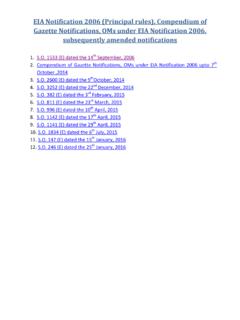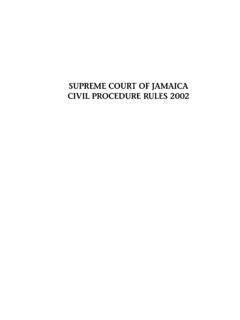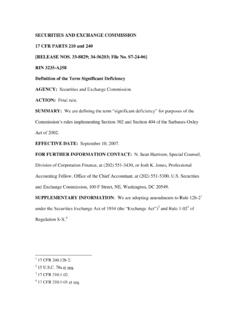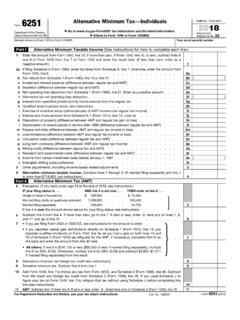Transcription of The international system of units (SI) - conversion factors for …
1 NIST Special Publication 1038 The international system of units (SI) conversion factors for General Use Kenneth Butcher Linda Crown Elizabeth J. Gentry Weights and Measures Division Technology Services NIST Special Publication 1038 The international system of units (SI) - conversion factors for General Use Editors: Kenneth S. Butcher Linda D. Crown Elizabeth J. Gentry Weights and Measures Division Carol Hockert, Chief Weights and Measures Division Technology Services National Institute of Standards and Technology May 2006 Department of Commerce Carlo M. Gutierrez, Secretary Technology Administration Robert Cresanti, Under Secretary of Commerce for Technology National Institute of Standards and Technology William Jeffrey, Director Certain commercial entities, equipment, or materials may be identified in this document in order to describe an experimental procedure or concept adequately.
2 Such identification is not intended to imply recommendation or endorsement by the National Institute of Standards and Technology, nor is it intended to imply that the entities, materials, or equipment are necessarily the best available for the purpose. National Institute of Standards and Technology Special Publications 1038 Natl. Inst. Stand. Technol. Spec. Pub. 1038, 24 pages (May 2006) Available through NIST Weights and Measures Division STOP 2600 Gaithersburg, MD 20899-2600 Phone: (301) 975-4004 Fax: (301) 926-0647 Internet: or TABLE OF CONTENTS 1 2 REFERENCE 3 SI Inch-Pound 4 GENERAL Preferred SI (metric) SI Base Table 1. The SI Base SI Derived SI Table 2. SI Editorial Accepted Unacceptable Metric Centimeter-Gram-Second (CGS) Table 3. CGS units Not to be Deprecated Names or Table 4.
3 Deprecated Names and Miscellaneous Non-SI units Not to be Table 5. Non-SI units Not to be iii Rounding Procedure for Technical Documents or Rounding Practices Used for Packaged Goods in the Commercial Temperature 5 DETAILED REQUIREMENTS AND conversion 6 DOCUMENT 7 iv FOREWORD This publication lists the units of the international system of units (SI), or metric system , recommended for use in trade and commerce and other general uses by the National Institute of Standards and Technology. Please submit comments or suggestions to the Editor at: Elizabeth J. Gentry National Institute of Standards and Technology Weights and Measures Division 100 Bureau Drive, Stop 2600 Gaithersburg, Maryland 20899-2600 E-mail: Visit our Website at: For information on scientific units go to: Telephone: 301-975-3690 FAX: 301-926-0647 v vi 1 SCOPE In 1988 Congress designated the international system of units (SI), the metric system , as the preferred system of measurement for use in trade and commerce (15 205 267).
4 This publication provides guidance on the use of the international system of units (SI) to ensure uniformity with the weights and measures usage in the commercial measurement system and in other applications. Government and industry use metric units for 1procurements, grants and other business-related activities, for educational information, and for guidance in publications. The practical guidance in this publication may be used for, but is not limited to, the drafting of laws, regulations, contracts, product specifications, purchase orders, and the preparation of public information, reports and brochures, correspondence, statistical tables, databases, and maps. In addition to serving as an authoritative document for the conversion of customary2 (inch-pound) units to metric, this publication also explains the relationship between metric units and inch-pound units .
5 2 REFERENCE DOCUMENTS This publication is based on National Institute of Standards and Technology (NIST) SP 330 international system of units (SI) (2001)( ), NIST SP 811 Guide for the Use of the international system of units (SI)(1995)( ), NIST 814 Interpretation of the SI for the United States and Metric conversion Policy for Federal Agencies (1998) ( ), and the IEEE/ASTM SI 10TM American National Standard for Use of the international system of units (SI): The Modern Metric system (2002), developed by the Institute of Electrical and Electronics Engineers, Inc., and the American Society for Testing and Materials (ASTM) international and other selected publications noted in Section 6 3 DEFINITIONS SI units units belonging to the international system of units (SI), as interpreted or modified for use in the United States by the Secretary of Commerce through the National Institute of Standards and Technology may be used in trade and commerce, procurements, grants and other business-related activities, in educational information, and as guidance in publications to increase understanding of the metric system .
6 Inch-Pound units units based upon the inch, pound, and gallon were historically derived from the English system and subsequently were re-defined as multiples of SI units in law beginning in 1893. For example, the inch is defined as the length corresponding to centimeters (exactly); and the gallon is defined as the volume corresponding to liters; in other words, the inch-pound (customary) units are based on the SI units and multiplication or division is used to convert units from one system to another. For example, since the inch was defined as the length corresponding to centimeters, in order to convert inches to centimeters multiply the value to be converted by An extensive set of conversion factors between the two systems of units is listed in Section 5.
7 In this document, the term inch-pound unit includes the degree Fahrenheit. Some inch-pound units , such as the gallon, have the same name as units previously used in other countries but differ in magnitude. When the term gallon is used, it means a gallon of 128 fluid ounces (231 cubic inches). 1 Vol. 63 No. 144; Page 40334, July 28, 1998, reprinted in NIST SP 814 2 Throughout this document the terms customary and inch-pound units will be used interchangeably. 1 4 GENERAL REQUIREMENTS Preferred SI (metric) units The SI units preferred for use are the units (together with their multiples and submultiples). SI Base units The SI is constructed from seven base units , which are adequate to describe most of the measurements used in science, industry and commerce.
8 Quantity Unit Name Symbol length meter m mass3kilogram kg time second s electric current ampere A thermodynamic temperature kelvin K amount of substance mole mol luminous intensity candela cd Table 1. The SI Base units . SI Derived units Derived units are formed for convenience of notation and are mainly used by various branches of science. They are obtained by combining base units and other derived units algebraically. The symbols for derived units are obtained by means of the mathematical signs for multiplication, division, and use of exponents. For example, the SI unit for velocity is the meter per second (m/s or m s-1), and that for angular velocity is the radian per second (rad/s or rad s-1). Some derived SI units have special names and symbols. Almost all physical measurements of science, industry and trade can be expressed in terms of these units or other combinations.
9 For convenience, however, other units can be derived from these, such as the hectare (ha) for an area of land or the liter (L or l) for volume, plus others (with symbols of their own) such as pressure (pascal) or electric resistance (ohm). SI Prefixes The units often have prefixes, indicating the power(s) of 10 by which a unit may be multiplied (for example, the prefix kilo in kilometer indicates that the unit kilometer is 1000 times larger than the meter). They are attached to an SI unit name or symbol to form what are properly called "multiples" and "submultiples" ( , positive or negative powers of 10) of the SI unit. These prefixes are helpful when referring to very small or very large quantities. Instead of creating a new unit, a prefix is added. For example, when measuring short lengths such as 1/1000th of a meter, we simply write millimeter; milli denotes 1/1000 th.
10 3 In commercial and everyday use, and in many technical fields, the term weight is usually used as a synonym for mass. This is how weight is used in most United States laws and regulations. See the note in section for further explanation. 2 The common metric prefixes are: Multiplication Factor Prefix Name Prefix Symbol 1 000 000 000 000 = 1012tera T 1 000 000 000 = 109giga G 1 000 000 = 106mega M 1 000 = 103kilo k 100 = 102hecto h 10 = 101deka da = 10-1deci d = 10-2centi c = 10-3milli m 001 = 10-6micro 000 001 = 10-9nano n 000 000 001 = 10-12pico p This table shows the common prefixes. Others, from 10-24 to 1024 are acceptable for use of the SI. See NIST SP 330. Table 2. SI Prefixes. Prefixes produce units that are of an appropriate size for the application, , millimeter for measurement of the dimensions of small screws, or kilometer for the measurement of distances on maps.














